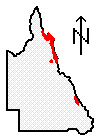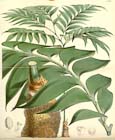Bowenia
Hook. f. 1863
Common names
Taxonomic notes
The genus contains 2 species:
Bowenia is sometimes placed in its own family, Boweniaceae. See Johnson (1959) for a more thorough treatment of systematics.
Description
Small, as cycads go. Stem fleshy, branching, subterreanean, naked, tuberous. Taproot tuberous. Separate leaf- and cone-producing branches. New leaves produced singly, coiled like watchsprings. Cataphylls irregular and when present short, flat, scattered among the leaf bases. Leaves erect, arching, bipinnate, one to seven on each rootstock branch, with long, slender petioles, swollen and hairy at the base; pinnae slender, spreading widely; pinnules opposite to alternate on each secondary rachis which itself ends in a terminal pinnule, thin textured, decurrent and stalked at the base, not articulate. Cones terminal on short branches of the rootstock, shortly stalked. Sporophylls peltate, the outer surface shortly hairy and lacking any spine or ornamentation. Seeds radiospermic, the sarcotesta cream to pinkish or purplish (Jones 1993).
Distribution and Ecology
Australia: coastal Queensland. Lowlands to moderate elevations or tablelands. Found within or on the fringes of rainforests, on protected slopes in open forest, and in riparian areas. Soils well-structured loams; fires uncommon (Jones 1993).
Remarkable Specimens
No data as of 2023.03.03.
Ethnobotany
Leaves are used commercially for decorative purposes. Plants are particularly popular ornamentals because of their small size and shade tolerance (Jones 1993).
Observations
Remarks
Named for G.F. Bowen, first governor of Queensland. Bowenia is first known from Eocene deposits at two localities in eastern Australia (Jones 1993).
Citations
Hooker, J.D. 1863. Curtis's Botanical Magazine 89, tab 5398. Available: Biodiversity Heritage Library, accessed 2012.11.25.
Johnson, L.A.S. 1959. The families of cycads and the Zamiaceae of Australia. Proceedings of the Linnean Society of New South Wales 84:64-117.
See also
The World List of Cycads.

